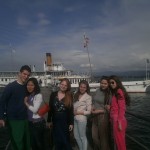 For most people in the west Easter is all about chocolate eggs and the Easter bunny. In Russia the Easter celebration is much about the religious aspect, although of course as it marks the end of Lent there also a lot of eating involved too. Russians typically celebrate Easter by eating kulich, a puffy raisin cake made with masses of eggs, butter and powdered sugar as well as those lovely dyed or painted hard-boiled eggs. The week before Easter keep your eyes open for markets, shops and street hawkers selling kulich. Prior to the holiday, Russians usually bring their cakes to church to be blessed by a priest, although you can sometimes spot priests blessing them in the streets near major supermarkets too.
For most people in the west Easter is all about chocolate eggs and the Easter bunny. In Russia the Easter celebration is much about the religious aspect, although of course as it marks the end of Lent there also a lot of eating involved too. Russians typically celebrate Easter by eating kulich, a puffy raisin cake made with masses of eggs, butter and powdered sugar as well as those lovely dyed or painted hard-boiled eggs. The week before Easter keep your eyes open for markets, shops and street hawkers selling kulich. Prior to the holiday, Russians usually bring their cakes to church to be blessed by a priest, although you can sometimes spot priests blessing them in the streets near major supermarkets too.The Easter service itself actually begins the night before Easter Sunday. People gather at church at around 23:00 to hear the Easter mass. At the end of the service, all the lights in the Church are turned off, except for the holy flame on the altar. Then at the stroke of midnight, Easter begins. The priest lights a candle from the holy flame and the congregation lights its candles from his, until the whole church is bathed in candle light. Bells begin to ring out across the city and the priest will then lead the congregation around the church three times in what is called ‘the cross procession’. Finally the doors of the iconostasis are opened, symbolising the opening of Christ’s grave after his resurrection. Easter services tend to last long into the night, although it is perfectly acceptable to arrive for just part of the service and light your candles. Finally after the service people head home and get ready for a day of feasting on Easter Sunday.





